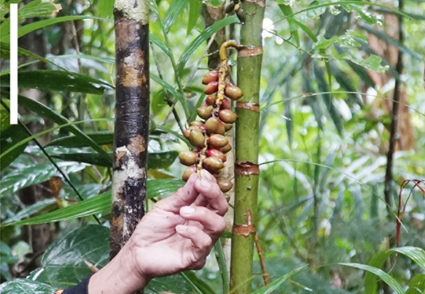Abstract
A new species of Pinanga, P. leonardcoi, from Mt. Cagua in northeastern Luzon, Philippines is described and illustrated. This novel palm belongs to the Urosperma group but is unique in having the combination of the following characters: clustered stems with stoloniferous off-shoots, few rachillae (2–3), spirally arranged fruits throughout the rachillae, and fruiting perianth with imbricate calyx lobes. Relevant morphological and ecological notes, and an updated key for the Urosperma group are also included. P. leonardcoi is a narrow-endemic species and is hereby assessed as Critically Endangered.
References
Bachman, S., Moat, J., Hill, A., de la Torre, J. & Scott, B. (2011) Supporting Red List threat assessment with GeoCAT: Geospatial conservation assessment tool. Zookeys 150: 117–126. https://doi.org/10.3897/zookeys.150.2109
Beccari, O. (1889) Nuove palme Asiatiche. Malesia 3: 169–200.
Beccari, O. (1907) Notes on Philippine palms, I. Philippine Journal of Science (Botany) 2: 219–240.
Becarri, O. (1909a) Notes on Philippine palms, II. Philippine Journal of Science (Botany) 4: 614–615.
Beccari, O. (1919) The palms of the Philippine Islands. Philippine Journal of Science (Botany) 14: 295–359.
Blume, C. (1838) Revue des palmiers de l’archipel des Indes Orientales. Bulletin des Sciences Physiques et Naturelles en Néerlande 1: 65.
Co, L.L. & Tan, B.C. (1992) Botanical exploration in Palanan Wilderness, Isabela Province, the Philippines first report. Flora Malesiana Bulletin 11 (1): 49–53.
Co, L., Lagunzad, D., Pasion, K.A., Consunji, H., Bartolome, N., Yap, S., Molina, J., Tongco, D.C., Ferreras, U.F., LaFrankie, J.V., Davies, S.J. & Ashton, P.S. (2006) Forest Trees of Palanan, Philippines: A Study in Population Ecology. Quezon City, Philippines.: Center for Integrative Development Studies, UP Diliman. 313 pp.
Copeland, E.B. (1931) New or interesting Oriental ferns. Philippine Journal of Science 46: 209–220.
Fernando, E.S. (1988) The mottled–leaved species of Pinanga in the Philippines. Principes 32 (4): 165–174.
Fernando, E.S. (1990) A preliminary analysis of the palm flora of the Philippine islands. Principes 34 (1): 28–45.
Fernando, E.S. (1994) New species of Pinanga (Palmae: Arecoideae) from Luzon Island, Philippines. Kew Bulletin 49 (4): 775–784. https://doi.org/10.2307/4118071
Fernando, E.S., Logatoc, E.L.R., Malabrigo, P.L.Jr & Adorador, J.T. (2020) Pinanga lepidota (Arecaceae: Arecoideae), a new record for the Philippines from Palawan Island. Philippine Journal of Systematic Biology 14 (3): 1–6. https://doi.org/10.26757/pjsb2020c14005
Heaney, L.R., Balete, D.S. & Rickart, E.A. (2016) The Mammals of Luzon Island: Biogeography and Natural History of a Philippine Fauna. Johns Hopkins University Press, Baltimore, Maryland. 304 pp.
IUCN (2012) IUCN Red List Categories and Criteria. Version 3.1, (2nd edn). Gland and Cambridge, 32 pp.
IUCN Standards and Petitions Subcommittee (2019) Guidelines for Using the IUCN Red List Categories and Criteria, Version 14. Prepared by the Standards and Petitions Subcommittee. Available from: http://www.iucnredlist.org/documents/RedListGuidelines.pdf (accessed 6 October 2021)
Lemaire, C. (1863) Pinanga maculata. L’Illustration Horticole 10: pl. 361.
Mayr, E. (2000) The biological species concept. In: Wheeler, Q.D. & Meier, E. (eds.) Species concepts and phylogenetic theory: a debate. Columbia University Press, New York, pp. 17–29.
Ormerod, P. (2014) Studies of West Malesian Agrostophyllum Blume (Orchidaceae), 2. Taiwania 59 (4): 331–339.
Ong, P.S., Afuang, L.E. & Rosell-Ambal, R.G. (eds.) (2002) Philippine Biodiversity Conservation Priorities: A Second Iteration of the National Biodiversity Strategy and Action Plan. DENR-PAWB, CIP, UP-CIDS, FPE. Quezon City.
Paguican, E.M., Grosse, P., Fabbro, G.N. & Kervyn, M. (2021) Morphometric classification and spatial distribution of Philippine volcanoes. Journal of Volcanology and Geothermal Research 418: 107251. https://doi.org/10.1016/j.jvolgeores.2021.107251
Pelser, P.B., Barcelona, J.F. & Nickrent, D.L. (eds.) (2011 onwards) Co’s Digital Flora of the Philippines. Available from: www. philippineplants.org (accessed 30 September 2021)
Sohmer, S.H. & Davis, A.P. (2007) The Genus Psychotria (Rubiaceae) in the Philippine Archipelago. Sida Botanical Miscellany 27: 1–247.
Smithsonian Institution. (2013) Global Volcanism Program. Available from: https://volcano.si.edu/ (accessed 13 October 2021).
Tryon, R. (1970) The classification of the Cyatheaceae. Contributions from the Gray Herbarium 200: 3–53.
van Welzen, P.C. (2017) Cyclopedia of Malesian Collectors Available from: http://www.nationaalherbarium.nl/FMCollectors/ (accessed August 30, 2021).
Vallejo, B. (2014) The Biogeography of Luzon Island. In: Telnov, D. (ed.) Biodiversity, Biogeography and Nature Conservation in Wallacea and New Guinea 2: 47–59.
Thiers, B. (2015 [continuously updated]) Index Herbariorum: A Global Directory of Public Herbaria and Associated Staff. New York Botanical Garden’s Virtual Herbarium. Available from: http://sweetgum.nybg.org/ih (accessed 23 February 2022)
Yap, S.L., Estacio, S.C.W., Paes, J.R.C. & Co, L.L. (2013) An account of the accessioned specimens in the Jose Vera Santos Memorial Herbarium, University of the Philippines Diliman. Science Diliman 25: 2, 67–77.


